NEWS 2005-2011
News
Kaizen
(June 2011)
Kaizen is factory improvement technique aimed at mindset change and continuous effort. The idea was imported from the US to Japan in the 1950s where it was further developed. Japan now provides kaizen assistance to many countries across cultures and regions. Introducing Kaizen in Africa
1/ Kaizen board at an Indian textile company in Kitwe, Zambia.
Many Indian companies practice and teach kaizen.
2/ Technical school in Vietnam carries "5S" slogans on the
wall which are seiri, seiton, seiso, seiketsu, shitsuke (sort,
straighten, shine, systematize, self-discipline; other translations are
also possible). It is the most basic kaizen technique.
3/ Workers paint yellow lines on factory floor for orderly
placement of equipment and inventory in Addis Ababa, Ethiopia.
4/ "Who others would ever do unless you do yourself !" in Hochiminh
City, Vietnam.
5/ 5S board in Thailand.
Industrial estates
(May 2011)
(1) AMATA Nakorn Industrial Park, Thailand. This huge
locally-managed private industrial estate recently created special rental
factory units (Ota Techno Park) to attract high-tech Japanese SMEs with
Japanese language and administrative support.
(2)Hsinchu Science Park, Taiwan. This state-owned park is home
to 449 high-tech firms, mostly local, producing ICs, LCD, etc. It receives
about 1,000 study missions per year from all over the world.
(3) Que Vo Industrial Park, Vietnam. Ms Hien, who speaks
Japanese, is a sales manager who wants about 50 Japanese parts &
components SMEs to come, but only two have signed the contract. This huge
space can be subdivided at firm's request.
Mt. Aso
(Apr. 2011)
Mt. Aso is an active volcano in Kyushu/GRIPS sakura in 2011.
Dubai
(July 2010)
Dubai (UAE) is an air transport hub between Europe and South Asia, Far East and Africa, and for all destinations in Middle East.
Central business district/coastal areas
Early summer flowers
(July 2010)
Ajisai (hydrangea) is everywhere during the rainy season
(June-July). It comes in red, pink, blue, purple, and white. (Right) gaku-ajisai, a different type of ajisai.
Blue ajisai (left) and fuyo (right). Fuyo also has many
colors. Its English name is cotton rose.
Asagao (morning glory) is a popular pot flower in July and
August.
Skyviews (May 2010)
When I fly I always take a window seat (not over the wing, please) to look down and take photos. I have no money for a space shuttle flight but at least I can be 10km above the sea level to enjoy the earth view.
Hiroshima / Tokyo & Kawasaki
Kobe / Yokohama
Kyoto / Fukuoka
My Vietnamese sons,
daughters and grandchildren
(Apr.2010)
I have studied Vietnam's development policy since 1995. I have also helped many street kids in Hanoi to receive education and training and start a business. Binh, one of the girls, graduated from my aid to become a hotel owner and manager. Her photo was in ADB's "Markets for the Poor" Report and DFID's monthly magazine. Others found jobs in embassies, shops and domestic service. Many boys became taxi drivers. Some are still selling in the street. Some became addicted to drugs.
Ha, Hoa and Vy
Hoa was among the first children I met. She was 12 then. She went back to school, graduated from a university, and is now married to Ha. Ha, also a former seller, now works as an embassy driver. We (Hoa, Ha & me) built a house last year. We live together like a real family when I am in Hanoi, with their daughter Vy (3 years old).
Binh was on the cover of an Asian Development Bank Report featuring the stories of 30 successful young entrepreneurs in Vietnam.
Thai-Nichi Institute of
Technology (TNI), Thailand
(Nov.2009)
TNI is a private university to teach Japanese style manufacturing in theory and practice. It was established in 2007 with the accumulated profit of TPA (an NPO created by former Thai students who studied in Japan). President Krisada studied engineering in Kyoto in the 1960s. Japanese government and companies assist TNI with TA, teaching, internship, scholarship and equipment donation. Japanese Government provides no financial assistance, however.
Machining practice/TNI building
Electrical classroom - not very different from similar
classrooms in other countries.
Automobile engines for testing and assembly practice,
donated by Japanese company.
Library.
Student canteen at lunch time.
Asagao
(July 2009)
Asagao (morning glory) is a popular summer flower in Japan. Every year on July 6,7,8 a street market appears in Iriya (near Ueno) to sell asagao pots. Asagao comes in different colors including red, pink, purple, blue, white, and brown.
Skyview
(May 2009)
Mt. Fuji from southeast.
Hiroshima on the Ota River Delta.
Tomb of Emperor Nintoku (5th century?) and other imperial
tombs in Sakai, Osaka.
Tsutsuji
(May 2009)
After sakura, we have the season of tsutsuji (azelea) which comes in various colors such as red, pink and white.
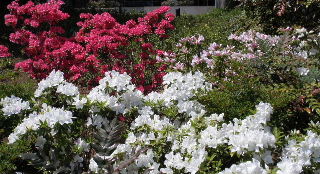
Yokohama+150
(May 2009)
Japan signed commercial treaties with the West in 1858, and free trade began in 1859. The port city of Yokohama was newly created from reclaimed land with foreign settlement area and Japanese area. In 2009 Yokohama celebrates its 150th birthday. Website: Y+150
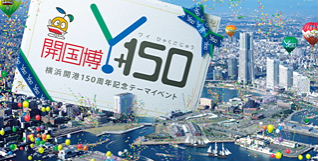
Sakura and Fuji
(March 2009)
The stereotyped view has it that Japan is a country of sakura (cherry blossoms) and Mt. Fuji. I hope you will experience both during your stay.
Nightly illumination of shidare-zakura (prunus pendula) at Rikugien
Park, Tokyo. shidare-zakura blooms ahead of somei-yoshino,
the most popular species of sakura.
The summit of Mt. Fuji as viewed from the altitude of 10,000m from the
south. Mt. Fuji can be climbed only in summer.
Tree flowers in Hanoi
(May 2008)
The red is phoenix flower (or flame tree) and the purple is violet crape myrtle. They are called Hoa Phuong and Hoa Bang Lang in Vietnamese. Click photos to enlarge
Mozambique
(Feb. 2008)
The Japan Bank for International Cooperation (JBIC) hosted two seminars on development planning around a large infrastructure (Nacala Corridor) in Mozambique where I was a guest speaker.
Click photo to enlarge
Views from Zambia (Dec. 2007)
I visited Zambia, a landlocked country in Southern Africa, in Sep. and Nov. 2007. I worked in Lusaka (capital), Ndola and Kitwe (two cities in Copper Belt) and took some photos.
CLICK PHOTO TO ENLARGE
Visiting Beijing (July 2007)
I attended a conference in Beijing (see news below for content). Before the conference, GRIPS Chinese alumni showed me around and invited me for two dinners. With a vibrant economy and the Olympic Games in 2008, Beijing is in a construction boom. The city has an extensive highway system, but air pollution and traffic congestion are severe. Beijing needs more subways to ease surface traffic (the city is building many more subway lines now).
CLICK PHOTO TO ENLARGE
Vietnam Development Forum (Apr. 2007)
VDF is a joint research project between GRIPS and Hanoi's National Economics University. It was established by me in early 2004 to conduct innovative policy research and support for Vietnam with strong networking among policy makers and researchers. It is funded by the research grant of Japan's Education Ministry (Monbukagakusho).
|
|
|
Main office in Hanoi |
|
|
|
Drafting motorcycle master plan with stakeholders |
|
|
|
|
|
|
| Chuong (coordinator) | Cuong (industries) | Hong (social issues) | Duc Anh (industries) | Ha Thanh (environment) |
|
|
|
|
|
|
| Huyen (marketing) | Hang (support) | Tu (SOE & finance) | Son (saving & invest.) |
Vietnam hosts APEC and joins
WTO (Jan. 2007)
|
|
|
| In Nov. 2006, the entire city of Hanoi was decorated with APEC banners and signs, which took several weeks to remove. This APEC didn't achieve much, but sponsoring a big international meeting without trouble was itself a great achievement for Hanoi authorities. | Vietnam was admitted to WTO in Nov. 2006. After parliamentary approval, it officially became the 150th member of WTO in Jan. 2007. Prime Minister Nguyen Tan Dung (and everyone else) said that this was both challenges and opportunities for Vietnam. |
| For the last 12 years I have been advising Vietnam to prepare concrete measures to compete globally, but I am afraid the effort was too little, too late in coming. Talking generally about "challenges" and "opportunities," at this late stage of integration, is a bit disappointing. Vietnam should already be implementing many concrete actions by now. | |
Street kids in Hanoi and Ho
Chi Minh City (June 2006 - click photo to enlarge)
Internal slogans of Japanese
FDI firms in Vietnam (May 2006)
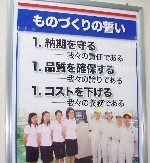 |
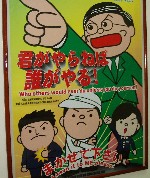 |
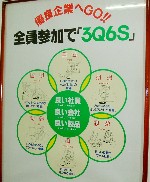 |
| Declaration on Monozukuri
(manufacturing)
-Keeping delivery time is our responsibility
|
"Who others would ever do
unless you do yourself!" "Leave it to ME please!"
|
Let's all participate in
3Q6S Quality Worker Seiri (removing unnecessary things) |
Map &
Photo Shop (Mar. 2006)
shop web
Last year, I opened this shop in Hanoi to hire my friends and produce new map & photo products. We created 2006 wall calendars featuring my photos. This year, I plan to publish a book entitled Vietnam Photo Diary.
Besides this, I provide loans to former street kids in Hanoi and Ho Chi Minh City to start their own business. This includes 3 hairdressers, 1 motorbike washing, 1 motorbike repair shop, and 1 clothes shop.
Can a professor be a
successful businessman?
(July 2005)
I have been doing research in Vietnam for ten years. During that time, I have also personally helped create a number of shops for my young friends (typically former street children) to manage. Here are some photos. I also wrote a short paper to explain why I am doing this.
Motorbike wash shop for boys in Ho Chi Minh City and Map &
Photo Shop in Hanoi. Both opened just recently.
Mini hotel (since 2001) and bag shop (since 2005) in Hanoi.
The rainy season and Ajisai
(June 2005)
From June to July, the stationary front stays at the eastern edge of the Eurasian Continent bringing rain to Japan. With rain, Japanese people think of ajisai (hydrangea) which blooms in blue, purple, pink, white, etc. With each rain, the color of ajisai is said to deepen.
Introducing Asuka, Azko & Atsuko (May 2005)
The quality of human resource is key to any effort, including research and teaching. We are lucky to have Asuka Suzuki (left) and Azko Hayashida, two competent research assistants, at GRIPS Development Forum. This month we also have Atsuko Danjo to support us. They are seated in Room E404. They prepare budgets, contact people, plan missions, organize meetings, edit books, design office space, create and maintain websites, coordinate within GRIPS, keep records, file reports, and more. They also assist VDF and our lectures too. I am not good at organizing things. Without them, my productivity will be much lower.
|
|
|
| Asuka Suzuki (left) and Azko Hayashida (center). We also have Atsuko Danjo (right) this and next months. | |
Introducing VDF (Apr.2005)--Vietnam
Development Forum is a joint research project between GRIPS and the
National Economics University in Hanoi (see below for more). It has been
in operation for one year and two months. It is located in a modern office
building in central Hanoi. It has ADSL and a meeting room with PPT
capability. We are now expanding its floor space to conduct more research
activities.
Meeting room - workshop in progress/Work space
Sakura (Apr.2005)--The peak time for cherry
blossoms is over in Tokyo, now the rain finishes its season. Japanese
people have a long history of loving sakura. Ancient literature frequently
featured sakura in the spring and momiji (colored leaves) in the autumn.
Sakura explodes its flowers dynamically but only for a short time. The
beauty of whole tree is appreciated, not individual flowers which are
small and similar to each other. This particularly seems to suit Japanese
sentiment (very different from roses). The most popular species today is
somei yoshino, created by somei village gardeners in the 19th
century. Before that, typical sakura put forward flowers and leaves
simultaneously, and its beauty was more subtle and modest.
more photos
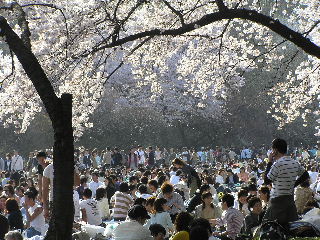
Shinjuku Gyoen, April 9, 2005
Sakura (Apr.2005)--Sakura (cherry flowers) is
now in full bloom in Tokyo (April 8-10). Please go and see them since they
will be gone by next week. Aoyama Cemetery, just 5-minute walk from GRIPS,
has sakura tunnels (see banner photo). Other popular spots are
Chidorigafuchi, Shinjuku Gyoen, and Koganei Koen. Night viewing and
drinking sake under sakura are also popular.
Welcome to new GRIPS (Apr.2005)--As we move
to the new Roppongi campus, I have decided to renovate my website. It may
not be perfect yet, so please be patient for the next few weeks. I will
try to fill more pages and fix broken links.